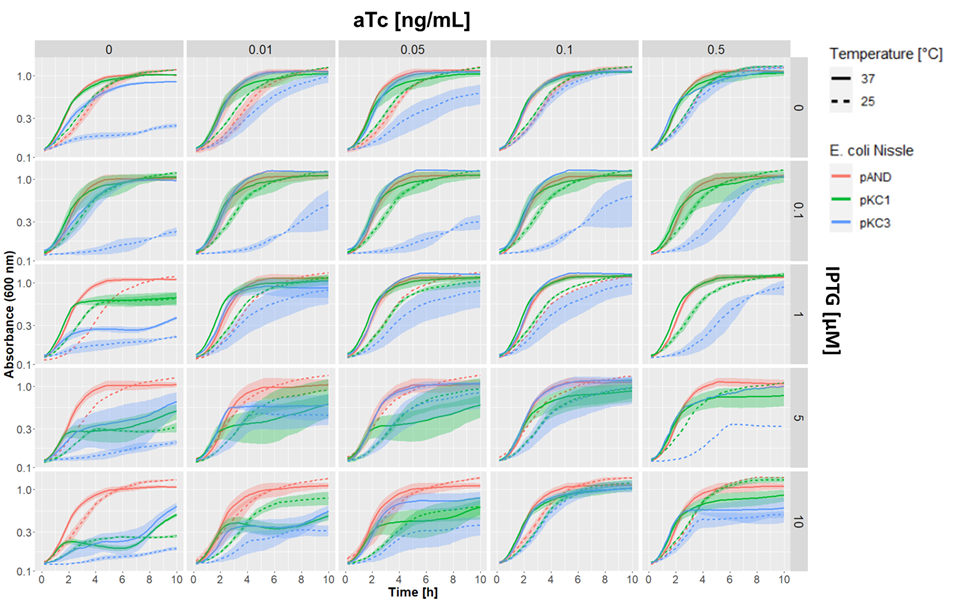Part:BBa_K3482017
aTc and heat-inducible IM2 antitoxin
IM2 immunity protein fused with an aTc sensible promoter and a heat-inducible ARN thermosensor.
Usage and Biology
Colicin E2 is an endonuclease that cuts on both single and double-stranded DNA. It has no specific cutting site. Colicins are toxins that can be produced by E. coli and closely related bacteria. The IM2 molecule gives an immunity to the Colicin E2 toxin
Characterization
We tested this part with the heat-repressible miniColicin toxin (BBa_K3482018) inserted on a plasmid. We inserted the heat-inducible RNA thermosensor upstream of the IM2 antitoxin genes in the plasmid pKC3. In order to demonstrate that the heat-inducible RNA thermosensor promotes the antitoxin synthesis and thus allows cells to grow in permissive conditions, we grew them at different temperatures and observed their growth curves. The backbone of the plasmid (pAND) and the plasmid pKC1 containing the toxin and the antitoxin, but no thermosensors were used as controls. Two different temperatures were chosen in order to test the permissive and non-permissive conditions, i.e. inside (37°C) and outside (≤25°C) the body, respectively.
Dose-response growth curve of E. coli Nissle 1917 ΔclbA harboring kill switch plasmids pKC1 and pKC3 at 37 and 25°C. E. coli Nissle with pAND (red line), E. coli Nissle with pKC1 (green line), and E. coli Nissle with pKC3 (blue line), at 37°C (dashed line) and 25°C (solid line). The lines and shade represent the mean ± standard error. Each plot shows the absorbance at 600 nm measured every 10 min for a period of 10 hours at different aTc and IPTG concentrations.
At permissive temperature (37°C) the pKC3 containing cells grew a bit slower than the two controls, but their viability was not impaired. Indeed, after 10 hours the cells containing either pAND or pKC1 seemed to reach a plateau where the pKC3 cells were still growing. At lower temperature (25°C), the viability of pAND and pKC1 cells remains unchanged while pKC3 growth was significantly impaired.
Thus we showed that the plasmid pKC3 containing the part BBa_K3482017 is able to control the viability of its host depending on the temperature.
Sequence and Features
- 10INCOMPATIBLE WITH RFC[10]Illegal SpeI site found at 90
Illegal PstI site found at 96 - 12INCOMPATIBLE WITH RFC[12]Illegal SpeI site found at 90
Illegal PstI site found at 96 - 21INCOMPATIBLE WITH RFC[21]Illegal BglII site found at 265
- 23INCOMPATIBLE WITH RFC[23]Illegal SpeI site found at 90
Illegal PstI site found at 96 - 25INCOMPATIBLE WITH RFC[25]Illegal SpeI site found at 90
Illegal PstI site found at 96 - 1000COMPATIBLE WITH RFC[1000]
| None |

